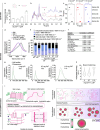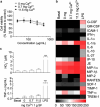Biomimetic Silk Nanoparticle Manufacture: Calcium Ion-Mediated Assembly
- PMID: 39883858
- PMCID: PMC11897946
- DOI: 10.1021/acsbiomaterials.4c02175
Biomimetic Silk Nanoparticle Manufacture: Calcium Ion-Mediated Assembly
Abstract
Silk has emerged as an interesting candidate among protein-based nanocarriers due to its favorable properties, including biocompatibility and a broad spectrum of processing options to tune particle critical quality attributes. The silk protein conformation during storage in the middle silk gland of the silkworm is modulated by various factors, including the most abundant metallic ion, calcium ion (Ca2+). Here, we report spiking of liquid silk with calcium ions to modulate the silk nanoparticle size. Conformational and structural analyses of silk demonstrated Ca2+-induced silk assemblies that resulted in a liquid crystalline-like state, with the subsequent generation of β-sheet-enriched silk nanoparticles. Thioflavin T studies demonstrated that Ca2+ effectively induces self-assembly and conformation changes that also increased model drug loading. Ca2+ incorporation in the biopolymer feed significantly increased the nanoparticle production yield from 16 to 89%, while simultaneously enabling Ca2+ concentration-dependent particle-size tuning with a narrow polydispersity index and altered zeta potential. The resulting silk nanoparticles displayed high biocompatibility in macrophages with baseline levels of cytotoxicity and cellular inflammation. Our strategy for manufacturing biomimetic silk nanoparticles enabled overall tuning of particle size and improved yields─features that are critical for particle-based nanomedicines.
Keywords: Bombyx mori; antisolvent precipitation; desolvation; metal ion; nanomedicine; silk fibroin.
Conflict of interest statement
The authors declare no competing financial interest.
Figures



References
-
- Saeedi M.; Vahidi O.; Moghbeli M.; Ahmadi S.; Asadnia M.; Akhavan O.; Seidi F.; Rabiee M.; Saeb M. R.; Webster T. J.; Verma R. S.; Sharifi E.; Zarrabi A.; Rabiee N. Customizing nano-chitosan for sustainable drug delivery. J. Controlled Release 2022, 350, 175–192. 10.1016/j.jconrel.2022.07.038. - DOI - PubMed
-
- Eichhorn S. J.; Etale A.; Wang J.; Berglund L. A.; Li Y.; Cai Y.; Chen C.; Cranston E. D.; Johns M. A.; Fang Z.; Li G.; Hu L.; Khandelwal M.; Lee K.-Y.; Oksman K.; Pinitsoontorn S.; Quero F.; Sebastian A.; Titirici M. M.; Xu Z.; Vignolini S.; frka-Petesic B. Current international research into cellulose as a functional nanomaterial for advanced applications. J. Mater. Sci. 2022, 57 (10), 5697–5767. 10.1007/s10853-022-06903-8. - DOI
MeSH terms
Substances
LinkOut - more resources
Full Text Sources
Miscellaneous
